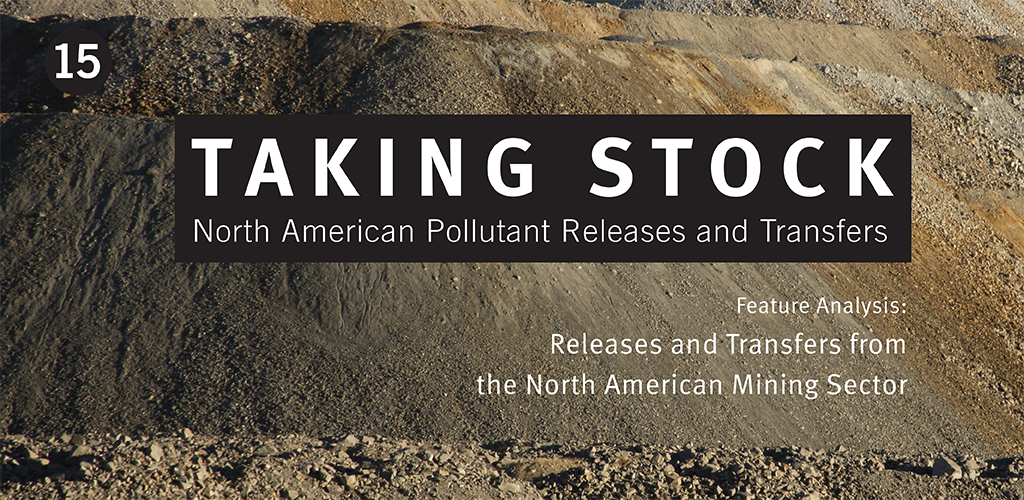New report provides most comprehensive accounting to date of industrial pollutants in North America
Flagship report and interactive infographic provide analysis of over 5 billion kilograms of reported pollutant releases and transfers from almost 200 industry sectors.
Montreal, 24 April 2018—The Commission for Environmental Cooperation (CEC) released today a report analyzing pollutant data reported by approximately 27,000 industrial facilities in Canada, Mexico and the United States to their national pollutant release and transfer registers (PRTRs). This 15th edition of Taking Stock: North American Pollutant Releases and Transfers also includes, for the first time ever, a special feature analysis of pollutant reporting by the North American mining sector.
A product of the CEC’s well-established North American Pollutant Release and Transfer Initiative, the Taking Stock report aims to foster greater understanding of the amounts, sources, and management of industrial pollutants in Canada, Mexico and the United States, with the objective of increasing dialogue across borders and supporting informed decisions relative to pollution prevention and reduction.
“North American industry provides us with the energy, materials and items that we rely on in our everyday lives. It also generates pollutants that must be managed to protect the environment and health of citizens across North America. The CEC is proud of this latest milestone in our ongoing collaboration with government, reporting sectors and civil society toward the goal of environmental sustainability within industry,” said César Rafael Chávez, CEC Executive Director.
Key findings of the report include:
- More than five billion kilograms of pollutant releases and transfers were reported by approximately 27,000 industrial facilities across North America in 2013, the latest data available for all three countries at the time of writing.
- Approximately 25 pollutants, from a relatively small number of industry sectors, accounted for at least 90 percent of total reported North American releases and transfers. However, due to differences among national PRTR reporting requirements, there are important data gaps across the region for a number of key industry sectors and pollutants (e.g., water and wastewater treatment plants, criteria air contaminants).
- Data from the mining sector reveal that, in 2013, the industry accounted for about 1.67 billion kilograms, or almost one-third of the region’s total releases and transfers—with about 99 percent consisting of releases or disposals to land.
- Most of the available data from the mining sector were reported in Canada and the United States—a finding that further highlights differences among national PRTR reporting requirements.
For a compelling snapshot of the data sets highlighted in the Taking Stock report, visit the CEC’s Taking Stock interactive infographic on North American industrial pollutant releases and transfers.
Report shines a spotlight on the North American mining sector
This year’s special feature, analyzing reporting by the North American mining sector, is the result of a collaborative effort among mining industry representatives, government, nongovernmental organizations, and academia to examine the mining sector data in the context of national PRTR reporting requirements. The analysis was undertaken in response to concerns raised during a public meeting of the CEC’s North American PRTR Initiative about uneven levels of reporting from this sector across the region.
The analysis shows that inconsistencies among national reporting requirements are a key contributor to the gaps in reporting by this North American sector. It also illustrates that total releases and transfers are not a very useful measure of the industry’s environmental performance or potential impacts, and points to other kinds of information that can be more valuable for tracking and preventing pollution—including details about spills or other unplanned releases that may occur even after mines have ceased to operate.
The insights gained from this in-depth analysis can inform improvements to the North American PRTR programs and environmental management initiatives within this important industry sector.
About the North American Pollutant Release and Transfer Initiative
The CEC’s North American Pollutant Release and Transfer Initiative promotes public access to data and information reported by industrial facilities in North America, in order to improve understanding of the sources and management of pollutants of common concern across the region and support decision-making relative to pollution prevention and reduction.
Begun in 1996, this initiative has been a cornerstone of the CEC’s work on pollutants and environmental health. Efforts are focused on adding value to national PRTR data through their integration, analysis and dissemination via the Taking Stock report series and Taking Stock Online, featuring a searchable database and web tools. The data are reported by industrial facilities to the three national PRTRs in North America: Canada’s National Pollutant Release Inventory (NPRI), Mexico’s Registro de Emisiones y Transferencia de Contaminantes (RETC), and the United States’ Toxics Release Inventory (TRI).

About the CEC
The Commission for Environmental Cooperation (CEC) was established in 1994 by the governments of Canada, Mexico and the United States through the North American Agreement on Environmental Cooperation, a parallel environmental agreement to NAFTA. As of 2020, the CEC is recognized and maintained by the Environmental Cooperation Agreement, in parallel with the new Free Trade Agreement of North America. The CEC brings together a wide range of stakeholders, including the general public, Indigenous people, youth, nongovernmental organizations, academia, and the business sector, to seek solutions to protect North America’s shared environment while supporting sustainable development for the benefit of present and future generations
The CEC is governed and funded equally by the Government of Canada through Environment and Climate Change Canada, the Government of the United States of Mexico through the Secretaría de Medio Ambiente y Recursos Naturales, and the Government of the United States of America through the Environmental Protection Agency.